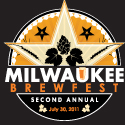Hi. My name is The Beer Wench, and I am a hop-aholic.
As a hophead, my go-to beers typically come from the ale family. India Pale Ales make my heart beat — and Double IPAs really get my heart racing. Nothing, however, gets me excited quite like an over the top hop heavy barley wine.
Barley wine shares many characteristics with wine – yet, despite its name, it is not actually a wine. Like a wine, it has a higher percentage of alcohol – ranging from 8% to 15% ABV. As a result of high levels of alcohol and high amounts of hops (both act as natural preservatives), most barley wines can be cellared for years and typically age like wine. Both go through fermentation and are aged in wood – but, the similarities pretty much end there. Wine is made from fermented grapes and barley wine is made from fermented barley malt. Wine is wine, barley wine is an ale.
Now if you remember from an earlier post, the equation for alcohol is quite basic:
yeast + sugar = alcohol
Every type of alcohol is made with both yeast and sugar. During fermentation, yeast eats the sugar. In the absence of oxygen, the yeast converts that sugar into ethanol and carbon dioxide. Ethanol is simply beverage alcohol. The sugar in beer comes from malted barley. The yeast in barley wine is ale yeast.
Knowing that barley wines are insanely high in alcohol, one can easily deduct – from the aforementioned formula – that they are also high in sugar. And this is a fact. Barley wines have substantially higher levels of malt than most ales. This is why brewers must use aggressive levels of hops to balance out the inherent sweetness. On average, the hops level of barley wines measure up to 100+ IBU (International Bittering Units).
Although this style ale has been brewed for centuries, the designation “barley wine” is relatively recent. It was introduced by Bass in 1903, appearing for the first time on the Bass No. 1 label. These beers were traditionally referred to as stock, old, or strong ales.
The formation of CAMRA (The Campaign for Real Ale) in the early 1970′s led to increased public interest and awareness of beer, at first in England, and then later in the “new world”. This heightened interest in traditional beer styles, such as barley wine. The early 1980′s marked the beginning of a “micro-brewery revolution” in the United States, increasing the popularity of barley wines.
The process of brewing barley wine can be a tedious one, as ale yeast tend to go dormant in high levels of alcohol, falling to the bottom of the fermentation vessel without completing the total fermentation. This leaves the beer very sweet. In order to overcome this issue, brewers use a technique called “rousing” -coaxing the yeast back into fermentation by gently stirring it up from the bottom – in combination with adding fresh, working yeast to finish the job.
Although golden-yellow hued barley wines exist, most typically range in color from amber to deep reddish brown. Body is typically thick, alcohol will definitely be apparent, and flavors can range from dominant fruits to palate smacking, resiny hops.
Barley wine is meant to be sipped and savored, not chugged. It can be drank immediately, while young, or cellared and enjoyed years after bottling. Barley wine is best when served in a tulip shaped glass or a Brandy snifter.
Here are a few excellent barley wines worth tasting:
Stone Old Guardian Barley Wine
Anchor Steam Barleywine Style Ale
Barley wines that I’m dying to taste:
Dogfish Head Olde School Ale (limited edition – not sure on its availablity)
Dogfish Head Palo Santo Marron (limited/ rare release – currently available at Wild Oats – hint hint)





















April 15, 2008 at 2:33 pm
[...] in the very near future. It might be a good idea to pick a beer theme such as ambers or porters (or barley wine?), but I’m still on the fence about [...]